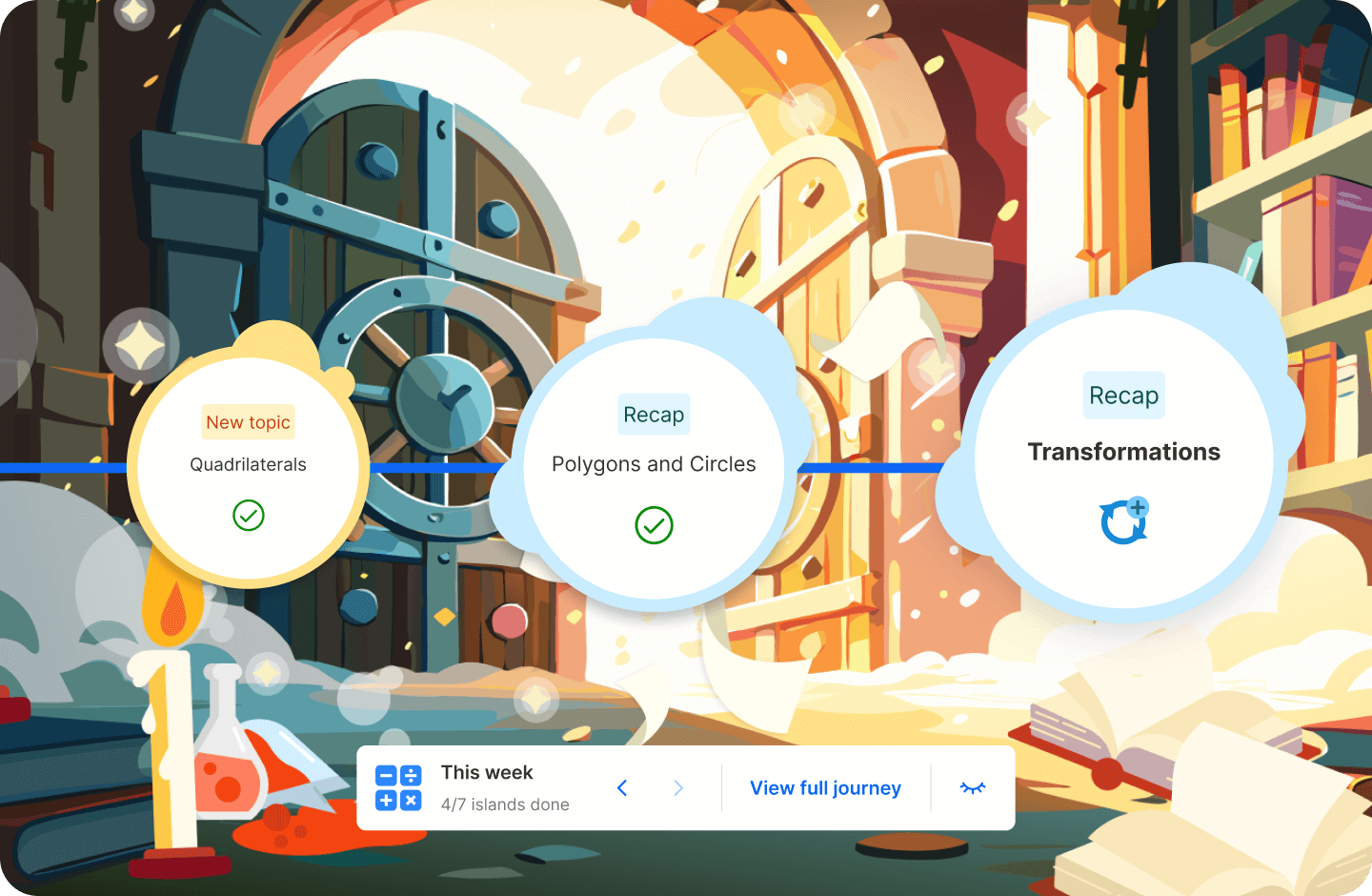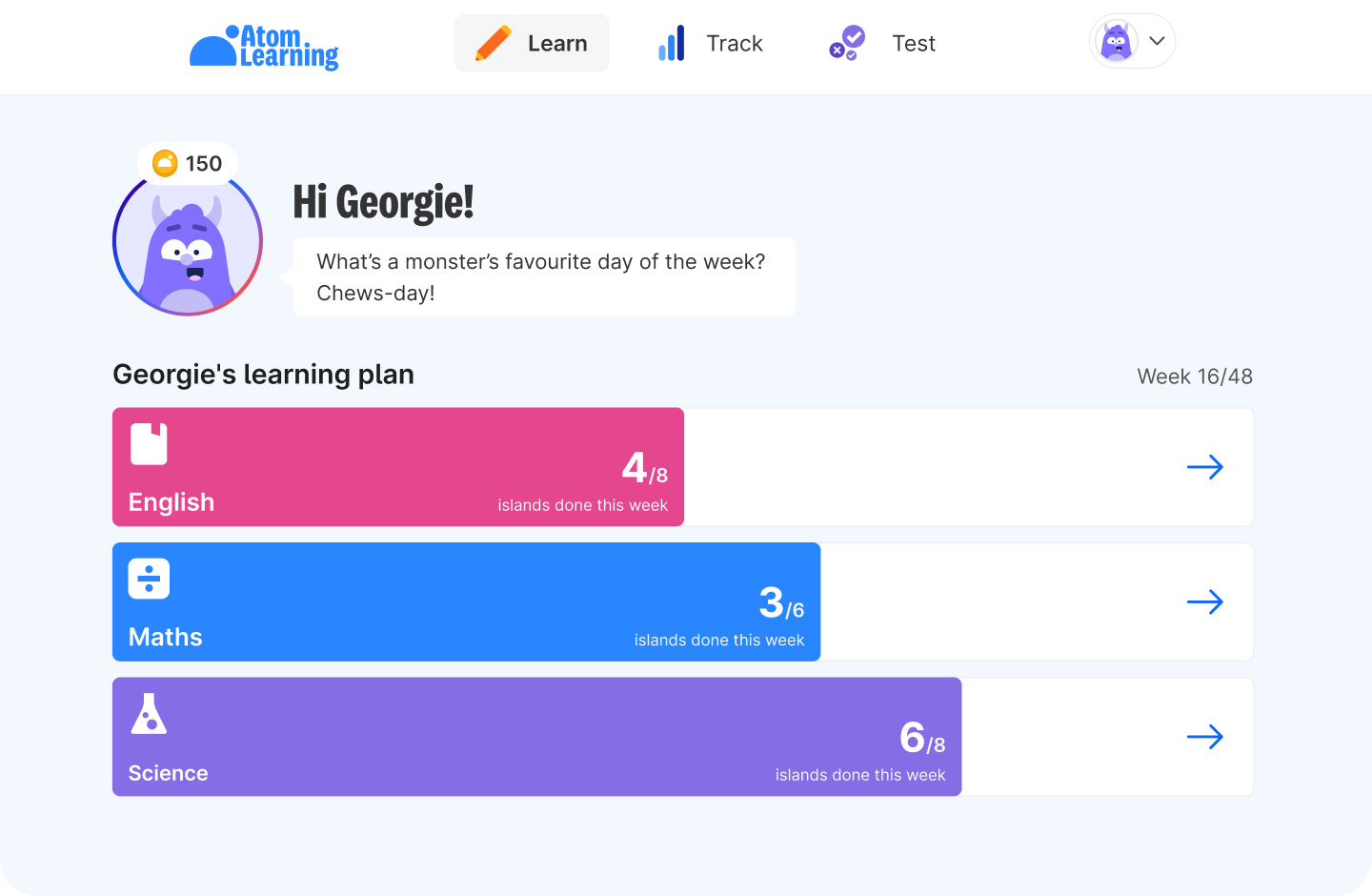Online learning is here to make your life easier and support your children to excel in the classroom and in exams. But did you know that our award-winning learning platform, Atom Nucleus, offers additional benefits for families – including a 20% sibling discount?
If you have more than one child in Key Stage 2 (ages 7–11), we can support them all to achieve their learning goals! Here's how to use Nucleus as a convenient home learning tool.
For 7–8 year olds (Year 3)
Home learning aims
- General learning
- Building confidence
- Establishing healthy learning habits
- Bridging learning gaps in English, maths and science
Benefits
Nucleus is ideal for getting younger children engaged with learning. This age group in particular will enjoy the friendly experience of exploring Learning Journeys with Ato as their guide. Small, regular sessions on Nucleus help to establish healthy learning habits early, which go on to help children for the rest of their academic career.
How to use
7–8 year olds may need support from their parents at first, particularly for topics they haven’t yet encountered at school. Encourage your child to explore the videos and helpsheets if they get stuck, and keep trying out questions independently. This will allow Atom’s algorithm to adapt to your child’s optimal level of challenge.

We recommend children in Year 3 take a little-and-often approach to their home learning.
- 3–4 weekly sessions of 20 minutes each.
- Most time should be spent in the Learning Journeys working through the curriculum.
- Set 2–3 Custom Practices per week to target areas your child has found challenging.
For 8–9 year olds (Year 4)
Home learning aims
- General learning
- Building confidence
- Bridging learning gaps in English, maths and science
- Introducing reasoning
- Beginning to prepare for entrance exams
Benefits
Being able to personalise Ato and earn ‘coins’ as they progress through the curriculum is particularly appealing to this age group!

If your child will be taking entrance exams to get into secondary school, the start of Year 4 is an ideal time to start introducing verbal reasoning and non-verbal reasoning (available on an Exam Prep subscription). These subjects are not taught at primary school, so getting familiar with the question types early will boost confidence when taking the 11 plus or ISEB.
Reasoning Learning Journeys are also helpful for children who aren't sitting entrance exams but want to practice their problem-solving, logic and pattern spotting skills. These topics tend to appeal to children interested in literature, languages, the arts (verbal reasoning), or STEM (non-verbal reasoning).
How to use
At this age, your child should be confident with learning independently. They should use the helpsheets and videos to explore new concepts and solve problems on their own.
Your child’s home learning schedule in Year 4 should be similar to the Year 3 schedule above. Children should continue to spend most of this time in the Learning Journey area, but towards the end of Year 4 you may wish to introduce a small number of Mock Tests (available on an Exam Prep Plus subscription). Nucleus Mock Tests are tailored for your child’s age and progress level – Year 4 children will see shorter Mock Tests as opposed to the full-length practice papers for Year 5s.
For 9–10 year olds (Year 5)
Home learning aims
- Developing reasoning skills
- Preparing for entrance exams
- Bridging knowledge gaps in English, maths and science
Benefits
Early Year 5 is the ideal time to begin structured preparation for school entrance exams next year. Atom Nucleus offers a full exam preparation package which your child can use anytime, anywhere.
At this stage, many children use Mock Tests to hone their exam technique and time management. Exam Prep Plus subscribers have access to full-length Mock Tests for grammar and independent schools, including tests tailored to specific schools and exam boards.
How to use
We recommend Year 5 children spend 2–2.5 hours on Nucleus each week, broken down into short sessions of 20–30 minutes.
Early on in Year 5, your child should spend most of this time in the Learning Journeys so they can build a solid understanding across the depth and breadth of the English and maths national curriculum, and all reasoning question types. Try setting two or three Custom Practices per week to target knowledge gaps.
Alongside this, introduce one or two Mock Tests per month so your child can get used to the format and scoring used in the real exams. We recommend using Mock Tests at weekends when children are less likely to be tired from school.
In the final six weeks before the exam, increase the number of Mock Tests to once or twice per week. Always take a few minutes to sit down together after a Mock Test to review the transcript and talk through any corrections – and of course, celebrate their effort. This step helps consolidate learning and keep motivation up.
For 10–11 year olds (Year 6)
Home learning aims
- Preparing for entrance exams
- Preparing for SATs
- Transitioning to secondary school
Benefits
Children applying to selective secondary schools will have entrance exams coming up between September and February of Year 6. Key Stage 2 SATs follow in May.
When preparing for exams, children should continue using the Learning Journeys to build a firm understanding of all English, maths and science curriculum objectives. They should also continue using the Mock Tests feature which will allow them to practice the specific test they will be taking. This will help them go into exam day feeling confident, knowing what to expect from the style, content and timings.
After exams, Nucleus is here to support children throughout the rest of Year 6 for a smooth transition into secondary education. Bridging any knowledge gaps now and consolidating Year 6 curriculum objectives will ensure they start secondary school on the best possible footing – and avoid the dreaded ‘Year 7 dip’ in attainment.
Continuing with home learning during Year 6 – particularly with reasoning – will also put children in a strong position for taking the CAT4, which many schools use at the start of Year 7 to stream students into sets based on academic ability and potential. Giving your child the best chance of being streamed into a top set at the start of Year 7 can influence the rest of their secondary school career.
How to use
By Year 6 children are capable of working fully independently on Nucleus. We recommend that children in Year 6 spend 2 to 2.5 hours each week, broken down into 20–30 minute sessions on the platform.
If your child is sitting an exam within six weeks, aim to complete one to two Mock Tests each week and use the results to identify learning gaps. You should then set targeted Custom Practices to target weaker areas (or let Atom's algorithm suggest practices for you).
After exams, most time on Nucleus should be spent in Learning Journeys. When your child demonstrates a strong mastery of a topic, more challenging early Key Stage 3 content will be unlocked. Your child should aim to maximise their Year 6 progress bar by the end of Year 6 to make sure they have mastered all Year 6 and early Year 7 curriculum objectives.
Year 6 Foundation Assessments on Nucleus are an easy way to gauge whether your child has embedded their knowledge of the Key Stage 2 curriculum. These adaptive tests asses every topic that a Year 6 student needs to master to be in a strong position for starting Year 7.


